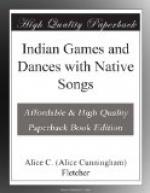In planning the pantomime for this stanza the dancers should not forget the rhythm of the song and to keep the lines as though they were walking between rows of tall cornstalks.
3
Where’er we look wide fields
wait harvest to meet;
Ripe are the ears we pluck, juicy the corn we eat;
Filling our arms, we go homeward, happy hearts there
we meet.
Refrain: Ah hey hey hey they,
Ah
hey hey they,
Ah
hey hey hey they,
Ah
hey hey they,
Ah
hey they.
The action requisite for the interpretation of this stanza by pantomime is comparatively easy, as looking over the field ready for harvest, and plucking a few ears of the corn. Care should be taken not to appear to touch the row where the seven hills were made, for the product of these are to be used as the “first-fruit offering.” During the singing of the first line of the third stanza a few of the dancers should slip behind some of the others and there take out their scarfs from the pouches or pockets, make each scarf into a loose bundle and carry it upon the folded arms as though it was filled with ears of corn. In this way, a few at a time, the dancers can secure their scarfs, and arrange them to look like bundles of corn to be taken homeward.
All the lines that have been moving as between rows of corn should now come together and form a long line and with dancing, rhythmic steps, and arms filled with corn, return to the starting place, and from there wind about the camp ground singing the refrain, which can be repeated ad lib. until they finally disperse and go to their tents.
DANCE V
Introductory Note.—This dance represents the bringing of the “first-fruit offering” of the corn from the seven little hills that were ceremonially planted after the dead leaves of winter had been cleared away. The dancers who follow the seven leaders carrying the cornstalks represent the people in triumphal procession in honor of Corn as “Mother breathing forth life.” Both words and music of the song for this procession are taken from a great religious ceremony of the Pawnee wherein Corn is spoken of as A-ti-ra, Mother, with the prefix H’ signifying breath, the sign of life. “H’A-ti-ra” ("Mother breathing forth life”) is repeated over and over and is the only word used in this song. The repetition is not an idle procedure but an awakening of echoes in the native mind, of all that Corn has meant to his ancestors and race during the centuries. The repeated words imply contemplation on the subject. This song when heard sung by a hundred or more could not fail to impress one with its majestic fervor. The beautiful, bountiful maize giving its life that others might enjoy life, on another plane, is here reverently and joyously proclaimed “Mother.”




